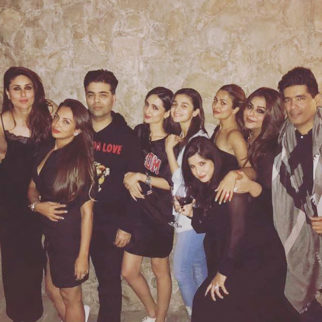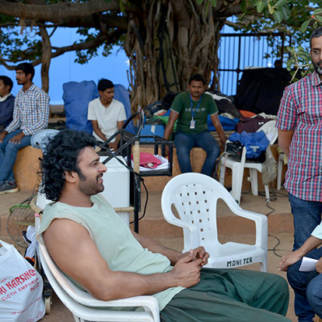Check out ADZ’s behind-the-scenes vfx
-
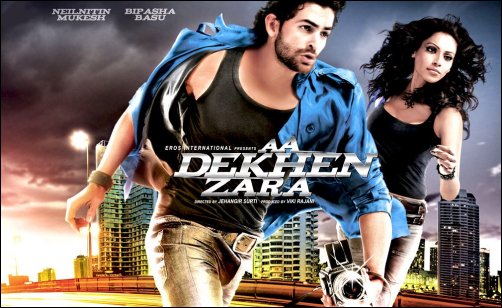 Eros International’s Aa Dekhen Zara, director Jehangir Surti’s maiden film, is premised on the novel concept of a camera as the protagonist. Although the movie is not a vfx heavy flick, it involves quite a few shots which are really commendable. Right from the initial days of production, Read More">the director worked closely with Mumbai basedRead More
Eros International’s Aa Dekhen Zara, director Jehangir Surti’s maiden film, is premised on the novel concept of a camera as the protagonist. Although the movie is not a vfx heavy flick, it involves quite a few shots which are really commendable. Right from the initial days of production, Read More">the director worked closely with Mumbai basedRead MoreEros International's Aa Dekhen Zara, director Jehangir Surti's maiden film, is premised on the novel concept of a camera as the protagonist. Although the movie is not a vfx heavy flick, it involves quite a few shots which are really commendable. Right from the initial days of production, the director worked closely with Mumbai based post-production studio FutureWorks, which did the visual effects, post and DI for the film.
When asked about the vfx in the film, which includes a unique 180 degree Milo shot, Jehangir says, "To be very honest I never thought of them as vfx shots but as parts of the story. When we sat down for production we realized that there are certain things that were impossible to do on-location. The film is a human drama and I wanted the vfx to be as real as possible and for people not to realize that it is vfx."
Editor Bunty Nagi adds, "For me a film is always about team work. The enthusiastic guys at FutureWorks make a very good team."
In a Bollywood Hungama vfx showcase special, we bring you a break down of some of the best shots executed by the post production studio.
Click here to check the vfx showreel, click on the arrow to view shot breakdown. -
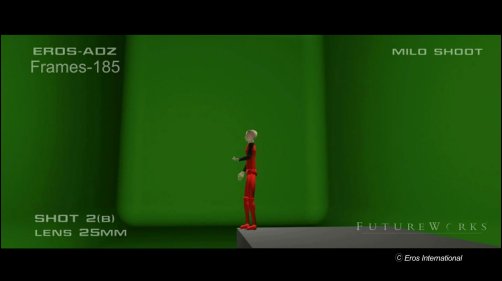 Time-travel Milo sequence This sequence appears at the fag end of the movie when Neil Nitin Mukesh opens up his grandfather’s watch, turns its dials and goes on a short time travel journey, spanning from a building towering the city to a desert to a dark tunnel. VFX supervisor for the film, Abhishek De says, Read More">Read More
Time-travel Milo sequence This sequence appears at the fag end of the movie when Neil Nitin Mukesh opens up his grandfather’s watch, turns its dials and goes on a short time travel journey, spanning from a building towering the city to a desert to a dark tunnel. VFX supervisor for the film, Abhishek De says, Read More">Read MoreTime-travel Milo sequence
This sequence appears at the fag end of the movie when Neil Nitin Mukesh opens up his grandfather's watch, turns its dials and goes on a short time travel journey, spanning from a building towering the city to a desert to a dark tunnel. VFX supervisor for the film, Abhishek De says, "The sequence has camera movement through the watch and then from location to location, with Neil in different costumes."
VFX expert Eric Alba from Los Angeles supervised the entire shoot. Neil had to understand and emote against a green screen with the pre-viz and rough backgrounds as his only aides. He had to do the same actions again and again, changing costumes and responding differently to different phases in the sequence. Care was taken to get the lighting proper during the shoot.
"The pre-visualization in 3D animatics was done to depict the size and height of floor, position of the track markers, chrome ball, so that we are very clear before we went on to the shoot," adds Abhishek.
Bimal Potdar worked on the matt paintings for the backgrounds and Mike Laxman designed the CG elements including the buildings, clouds and the truck. In all there were 60 layers that were rendered as separate passes and composited on Flame by Deepak Pais. "The brief was to make it as real as possible. The director was specific about what the backgrounds would look like," adds Abhishek.
This is what director Jehangir Surti had to share, "Despite the accuracy of a Milo shoot, due to the human element involved in it there are bound to be errors. The FutureWorks team came in and made sure that we came as close to perfect. I told them I wanted a city, they came up with the backgrounds. I did not want the Milo to look like a Milo. People are aware of clothes being changed but not background. I wanted it to be as simple as possible, something that takes a lot of effort."





-
 Chroma shots Several shots in the film were shot in studio against chroma screens and outdoor footage was later composited into the sequences. For eg, Read More">shots of Bipasha and Neil Nitin’s arrival in Thailand were shot in a stationary car against a chroma background in a Mumbai studio and the footage of Bangkok streets wasRead More
Chroma shots Several shots in the film were shot in studio against chroma screens and outdoor footage was later composited into the sequences. For eg, Read More">shots of Bipasha and Neil Nitin’s arrival in Thailand were shot in a stationary car against a chroma background in a Mumbai studio and the footage of Bangkok streets wasRead MoreChroma shots
Several shots in the film were shot in studio against chroma screens and outdoor footage was later composited into the sequences. For eg, shots of Bipasha and Neil Nitin's arrival in Thailand were shot in a stationary car against a chroma background in a Mumbai studio and the footage of Bangkok streets was later composited into the sequence.



-
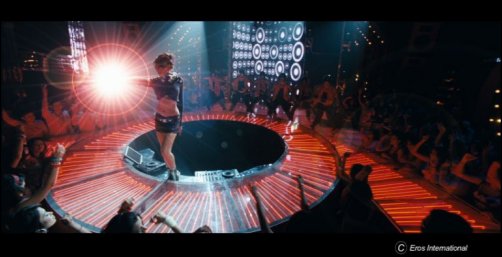 Digital Intermediate The DI for the film was completed in a span of 10 days, with the director, DOP Jehangir Chowdhary, editor Bunty Nagi and senior colorist Ashish Nanajkar virtually camping in the digital suite at FutureWorks. The entire film was scanned as per the edit and then assembled on the Quantel Pablo, Read More">after whichRead More
Digital Intermediate The DI for the film was completed in a span of 10 days, with the director, DOP Jehangir Chowdhary, editor Bunty Nagi and senior colorist Ashish Nanajkar virtually camping in the digital suite at FutureWorks. The entire film was scanned as per the edit and then assembled on the Quantel Pablo, Read More">after whichRead MoreDigital Intermediate
The DI for the film was completed in a span of 10 days, with the director, DOP Jehangir Chowdhary, editor Bunty Nagi and senior colorist Ashish Nanajkar virtually camping in the digital suite at FutureWorks.
The entire film was scanned as per the edit and then assembled on the Quantel Pablo, after which the team went about colour correcting the film, to bring the director's vision to life. The 'DI' begun with the process of 'dust busting' (removing small specs of dirt from the scanned film to make the image clearer).
Ashish says, "DI is the entire process from the negative to the digital medium and back to the negative, including colour grading, effects, keying and masking. The film was shot in the monsoons and colour correction gave it a uniform tone."
The DoP, especially, was very particular about the look of a few songs, says Ashish. The song in the club with Bipasha as the DJ was shot with lots of strobe lights and colours. "The DoP's fantastic job was further made even more pronounced and better in the DI," adds Ashish.
A golden touch was given to Bipasha's skin to give it a warmer and richer look. Director Jehangir Surti says, "Bipasha being Bipasha, you don't need to do much. The amazing thing about the DI done here is the subtlety of it. It's easy to tone stuff, and stylize it. Here I was very clear that the colour correction should not take away from the story."
During a song sequence in a village in Thailand, it was raining during the indoor shoot. Says Jehangir Surti, "It was a junk collector's barn and there was no space to light from above. Despite windows all around, we could not light from the outside as it was raining cats and dogs. We had to set up the lights inside, and the rest was taken care of during the DI." Other instances where colour correction was used extensively include the shot when Neil Nitin examines his grandfather's boat and an outdoor shot of a Mumbai hotel which was shot during the daytime but made to look like dusk.
The director gives credit to the FutureWorks' DI team, "We have been successful in doing something without shouting. Even though it was my first DI, we have been able to get the colours and tones which were emotionally correct for the film.



-
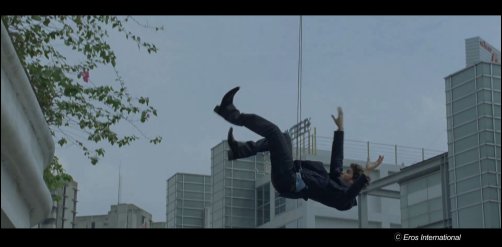 Wire removals Various action sequences- like Bipasha pushing Neil Nitin off the hotel terrace and then jumping off herself – involved wire removals. The shots were also colour corrected to give them the desired look. Besides this, the sequence in which a lady and her son fall off a ferries’ wheel also involved wire removal.
Wire removals Various action sequences- like Bipasha pushing Neil Nitin off the hotel terrace and then jumping off herself – involved wire removals. The shots were also colour corrected to give them the desired look. Besides this, the sequence in which a lady and her son fall off a ferries’ wheel also involved wire removal.Wire removals
Various action sequences- like Bipasha pushing Neil Nitin off the hotel terrace and then jumping off herself - involved wire removals. The shots were also colour corrected to give them the desired look. Besides this, the sequence in which a lady and her son fall off a ferries' wheel also involved wire removal.



